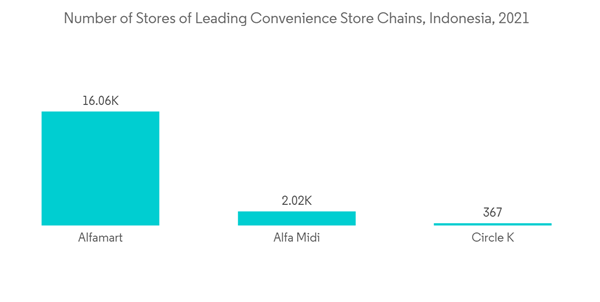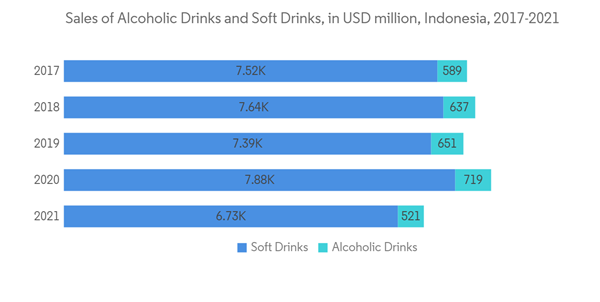The Indonesia Metal Packaging Market is expected to grow at a CAGR of 3.6% over the forecast period. Evolving market dynamics where consumer shift towards the usage of processed food and beverages in their food habits is expected to aid the growth of the metal packaging market.
In July 2022: The National Agency of Drug and Food Control, Badan Pengawas Obat dan Makanan (BPOM) issued a notice to adjust the limits of heavy metals allowed in processed foods that will be enforced over 12 months. In order to protect the community from contamination in the food supply and to increase the competitiveness of Indonesian processed food products, heavy metals are a key area of governance focus. BPOM decided to update the heavy metal contamination limits in the Regulation on Requirements for Heavy Metal Contaminants in Processed Food, which will replace the previous regulations last amended in 2018.
Major heavy metals that will be monitored included arsenic, plumbum, cadmium, mercury and tin. Multiple processed food product categories including dairy, frozen foods, spreads, confectionary, cereals, bakery goods, edible oils, bottled water, non-alcoholic drinks, alcohol, coffee, tea, snacks and more all have new set heavy metal limits which manufacturers will need to transition to over the next year in order to avoid being hit with penalties.
Additionally, all corporations that deal with the production, storage, transportation and/or distribution of processed foods are responsible to meet the criteria and standards of heavy metal limits in the items within their purview. Both organised and unorganised corporations that handle processed foods will have to comply to this, and failure to do so will result in fines. These new contamination standards apply not only to locally manufactured products, but also imported ones, which will be subject to the relevant analysis by either local or foreign accredited laboratories. All imported processed food products will need to have been tested via validated or verified methods of analysis, and this must be done by suitable accredited laboratories in accordance with the law.
Further the agency has added that If the analysis has been done in a lab at the product’s country of origin, the results must get mutually recognised by the authorised institution and/or accredited laboratories in Indonesia. Enforcement of these standards are to begin in 2023. All product manufacturers will need to make the transition to meet these before enforcement and monitoring is implemented in the second quarter of 2023.
This product will be delivered within 2 business days.
Key Highlights
- The growth of high disposable incomes in the country contributes to the development of metal cans. In addition, urbanization and growing middle-class incomes are driving demand for packaged foods, leading to increased production capacity for food and beverage manufacturers. Further, the growth of the metal can have been driven by the growing consumption of beverages such as tea, iced coffee, and soft drinks.
- Furthermore, increasing construction activities in the country and government infrastructure initiatives such as recently announced infrastructure budgets for building a new capital city, as well as growing urbanization are the factors creating a demand for paints and coating products, which are expected to drive growth in the metal packaging market by creating the need for metal packaging solutions.
- However, adopting low-cost alternative packaging products made of paper and plastic restricts the market's growth, especially for metal cans. Moreover, incremental enhancements in plastic packaging pose a threat to the market, which can primarily be allocated to the popularity of plastics, such as polyethylene terephthalate (PET), as substitutes. PET plastics threaten to displace metal container packaging solutions in the food and beverage sector.
- The COVID-19 outbreak and the resulting economic downturn have negatively impacted metal packaging sales volume in Indonesia. Steep changes due to the pandemic characterize the supply-demand dynamics of the country's metal packaging industry. The pandemic highlighted the country's need to focus on developing its domestic market and decrease over-dependence on international markets for raw materials, food products, and exports. It has led to new investments marking expansion projects for various key players in the studied market, supporting its growth. Further, the Russia-Ukraine war has impacted the overall packaging ecosystem leading to increased raw material prices.
Indonesia Metal Packaging Market Trends
Growing Demand for Convenience Food
- As Indonesia is among the emerging economies in Southeast Asia with a rapidly growing middle-class population, the demand for convenience food is increasing with rising numbers of convenience stores outside Java and major urban areas.
- The increasing consumer preferences for convenience foods is a crucial factor driving the growth of packaged food in Indonesia. Due to the growing convenience factor, there has been an exponential growth of packaged food, including canned food, packaged food or meals, frozen food, preserved food, and instant products, driving demand in the metal packaging market.
- According to the USDA Foreign Agricultural Service, in 2021, revenue from packaged foods has shown a considerable rise. The confectionary packaged goods sales were USD 1,897 million in the year 2021. In the same year, the total retail sales value of packaged food increased to around USD 32.97 billion from USD 32,264 million in 2020.
- Moreover, to cater to the growing need for convenience foods in the urban areas of Indonesia, convenience store chain operators are expanding their operations by adding new outlets. In 2021, the Alfamart convenience store chain added more than 1,000 minimarts to bring its total store count to over 19,500.
Beverage Industry to Hold Major Share in the Market
- Beverage sales are still increasing, owing to ongoing economic development, rising incomes, and population growth. However, to transform the Indonesian economy, the government is pursuing policies that reduce the country's reliance on imports and strengthen the manufacturing sector, which benefits the beverage sector.
- Despite being affected by the COVID-19 pandemic, the food and beverage industry remains resilient, growing 3.68% in the second quarter of 2022, a significant increase from 2.95% in the same period in 2021, according to the government of Indonesia. Furthermore, food and beverage industry exports reached USD 21.3 billion in January-June 2022, up 9% from USD 19.5 billion in the same period in 2021.
- Moreover, in May 2021, Nestle started constructing a beverage can plant in Batang, Indonesia. To fulfil growing consumer demand, the factory would produce Bear Brand liquid milk and ready-to-drink beverages, Milo and Nescafe. With the construction of the new factory, the company has signed an agreement with the Batang regional government to form a partnership with prospective dairy farmers and farmer groups to source additional raw materials for production. Key end-user players' initiatives in response to market development support metal packaging growth.
Indonesia Metal Packaging Market Competitor Analysis
The Indonesia Metal Packaging Market is fragmented, with the presence of global and domestic vendors operating in the market with considerable market share and aiming for different approaches such as acquisitions, mergers, technological advancements, expansion, and tactics to strengthen their positions. Some of the other key players are PT Pelangi Indah Canindo Tbk, PT Indonesia Multi Colour Printing, Rheem Indonesia, Sonoco Indonesia, and others.In July 2022: The National Agency of Drug and Food Control, Badan Pengawas Obat dan Makanan (BPOM) issued a notice to adjust the limits of heavy metals allowed in processed foods that will be enforced over 12 months. In order to protect the community from contamination in the food supply and to increase the competitiveness of Indonesian processed food products, heavy metals are a key area of governance focus. BPOM decided to update the heavy metal contamination limits in the Regulation on Requirements for Heavy Metal Contaminants in Processed Food, which will replace the previous regulations last amended in 2018.
Major heavy metals that will be monitored included arsenic, plumbum, cadmium, mercury and tin. Multiple processed food product categories including dairy, frozen foods, spreads, confectionary, cereals, bakery goods, edible oils, bottled water, non-alcoholic drinks, alcohol, coffee, tea, snacks and more all have new set heavy metal limits which manufacturers will need to transition to over the next year in order to avoid being hit with penalties.
Additionally, all corporations that deal with the production, storage, transportation and/or distribution of processed foods are responsible to meet the criteria and standards of heavy metal limits in the items within their purview. Both organised and unorganised corporations that handle processed foods will have to comply to this, and failure to do so will result in fines. These new contamination standards apply not only to locally manufactured products, but also imported ones, which will be subject to the relevant analysis by either local or foreign accredited laboratories. All imported processed food products will need to have been tested via validated or verified methods of analysis, and this must be done by suitable accredited laboratories in accordance with the law.
Further the agency has added that If the analysis has been done in a lab at the product’s country of origin, the results must get mutually recognised by the authorised institution and/or accredited laboratories in Indonesia. Enforcement of these standards are to begin in 2023. All product manufacturers will need to make the transition to meet these before enforcement and monitoring is implemented in the second quarter of 2023.
Additional benefits of purchasing the report:
- The market estimate (ME) sheet in Excel format
- 3 months of analyst support
This product will be delivered within 2 business days.
Table of Contents
1 INTRODUCTION
4 MARKET INSIGHTS
5 MARKET DYNAMICS
6 MARKET SEGMENTATION
7 COMPETITIVE LANDSCAPE
Companies Mentioned (Partial List)
A selection of companies mentioned in this report includes, but is not limited to:
- PT Pelangi Indah Canindo Tbk
- Sonoco Products Company (Sonoco Indonesia)
- PT Indonesia Multi Colour Printing
- Crown Holdings, Inc.
- PT United Can Company Ltd.
- PT Indonesia Raya Makmur
- Rheem Indonesia
- PT Cometa Can Corporation
- P.T. New Red & White
- ATP Group
Methodology

LOADING...










